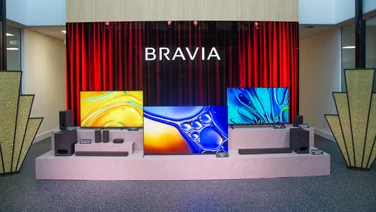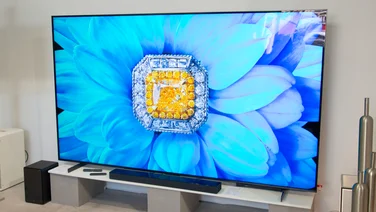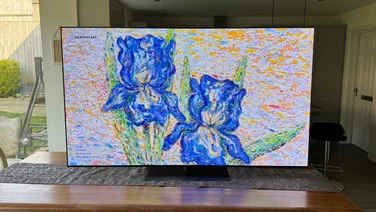To help us provide you with free impartial advice, we may earn a commission if you buy through links on our site. Learn more

- Ambilight reduces eye strain
- Best above-black OLED performance to date
- Incredible, judder-free motion
- Input lag is higher than its rivals
- No Dolby Vision
- No 3D
Philips has never been a company that follows convention. The TV brand, now owned by TP Vision, was responsible for quirky designs such as the now-retired CinemaScope television with its ultra-wide 21:9 aspect ratio, and its Ambilight feature introduced integrated bias lighting technology – aka TVs with strips of coloured lighting at the rear – to lounges across the world. But through it all, it’s the brand’s picture processing prowess that has always been consistently impressive. Suffice to say, the Philips 55POS901F – the company’s first foray into OLED TV – is another pixel-perfect success.
READ NEXT: The best 4K, HDR and OLED TVs to buy from £559
Aren’t all 4K OLED TVs born equal?
Some quarters mistakenly believe that since all current 4K OLED TVs on the market use the same panel from LG Display, image quality should be identical across the board, but nothing could be further from the truth. After spending extensive time testing the 55in Philips 901F alongisde a 2016 LG OLED, we found image quality improvements in several areas owing to Philips superior picture processing sauce.
The first big improvement is onscreen motion. Not only does the 55POS901 handle slow panning shots from 24p movies smoothly without excessive judder, the TV also offers a truly remarkable Perfect Clear Motion setting that improves motion clarity (in fact, motion resolution more than doubles from 300 to 650 lines) without introducing visible interpolation artefacts, or adding an overly smoothed soap opera effect. Amazingly, there aren’t even any of the usual side effects to black frame insertion/backlight strobing, such as visible flicker or drop in screen brightness. We watched plenty of football on the Philips 901, and the display delivered the clearest artefact-free motion we’ve seen from a 4K OLED television to date.
The best OLED image quality yet
The Philips OLED also betters LG’s 2016 models for shadow detail and screen uniformity. Although all OLEDs can produce true, perfect blacks (unlike rival screen technologies, OLED produces no light at all when it’s displaying black), the traditional sticking point has been that OLED struggles to discern between black and very dark greys. We tested several dark movie scenes on the 55POS901F, and it consistently displayed those tricky almost-black greys with less noise and blockiness than the 2016 LG OLED. The result? Movies on the Philips look just that bit more solid and immersive, which serves to add extra drama to the whole viewing experience.

One of Philips’s key selling points is – and always has been – Ambilight. The 901F OLED uses a 3-sided version, with three strips of LEDs at the rear of the chassis projecting ambient lighting onto the wall behind. While some viewers prefer to watch OLED TVs in a pitch-black room to savour the inky blacks, it can be a recipe for tired eyes as your pupils constrict and dilate in response to brighter and darker scenes on screen. By providing a subtle amount of background lighting to prevent your pupils from being overworked, Ambilight is extremely effective at reducing eye fatigue. That said, we weren’t overly keen on the default Ambilight mode as it’s too distracting – it dynamically changes according to the video content. Instead, we opted for a static low-level illumination which worked to minimise eye strain without drawing attention to itself.
OLED display technology provides a whole host of benefits. Ultra-wide viewing angles mean that there’s no significant drop-off in contrast and colour saturation even if you’re viewing the TV as far as 60° off-centre, and there’s also no need for bulky backlights or layers of filters and TFTs panels, so it’s possible to create stunningly slender TVs. Philips has taken full advantage of this for the 55POS901 which features a super-slim panel and bezel, luxurious-looking brushed metallic silver finish, and even manages to squeeze in an integrated 6.1 soundbar. The only minor gripe is that the supporting feet are positioned at either edge of the base – owners will need a surface at least 120cm long on which to place the TV.
While its integrated soundbar bears a Dolby logo, the Philips 901 doesn’t support Dolby Vision (or 3D for the matter). That said, the Ultra HD Premium-certification means that the 55POS901’s HDR10 playback from 4K Blu-rays and Netflix/ Amazon streaming was as good as we’ve seen from an OLED television – we noted no issues with accurate tracking of the PQ (perceptual quantisation) HDR standard – though we did need to up the Colour setting in the onscreen display to rectify the slight undersaturation caused by out-of-the-box settings.
HDR and gaming performance
Is the Philips as bright as the best LED LCD TVs? No. None of the current crop of OLED TVs can go as bright (the 901F’s peak brightness is a relatively modest 640 nits) or resolve as much highlight detail as top-tier LED TVs, but as these suffer from various image quality issues such as blooming, haloing or elevated blacks in HDR mode, it’s very much a case of picking your own poison.
If there’s a chink in the Philips’ armour, it’s that gaming isn’t one of its strong points – or at least it isn’t if you want to be competitive in online games where reaction speed is a factor. Indeed, twitch gamers may want to give the Philips 55POS901F a skip. Input lag measures at around 59ms in Game and HDR Game modes, which whilst not terrible, isn’t quick enough for a perfect gaming experience either. By comparison, LG’s 2016 OLEDs have sub-40ms input lag, and 2017 models will be closer to 20ms. Philips needs to play catch up in this regard.
Verdict
It’s no surprise to find that Philips’ first foray into OLED is something very, very special indeed. The 55POS901F/12 doesn’t just hold the honour of being the best TV Philips has produced, but it’s also one of the best OLED TVs we’ve reviewed to date thanks to its superior motion sharpness and above-black handling. If you’re looking for the best OLED TV you can buy right now, then LG’s OLED55B7V (read our full review here) narrowly pips it overall – but this is a TV that definitely deserves to make your OLED shortlist.






